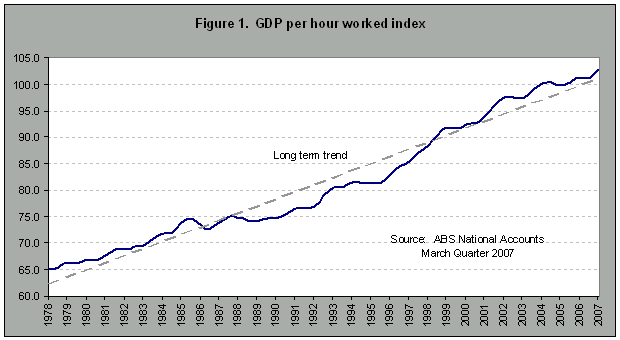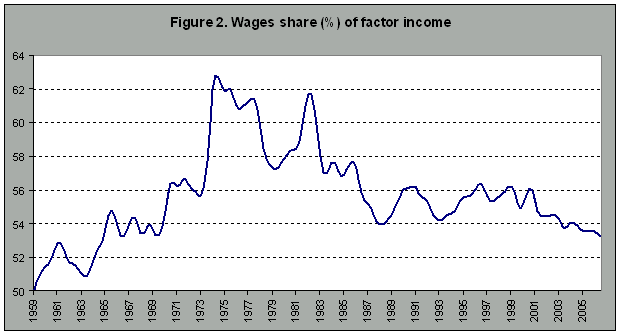Productivity – a dead end?The word ‘efficiency', Lindy Edwards points out, has become disconnected from economic reality. And it has become a matter of nitpicking between the two major parties. In the March quarter National Accounts, the Government took glee in finding a rise in productivity. After three years of flat performance, productivity finally showed a small rise in the latest two quarters. Thus was the Government's WorkChoices policy apparently vindicated.
It's a sign of our times that politicians should become excited by one statistical estimate, in a data series subject to noise and sampling error. In all probability the recent rise is simply a statistical return to the trend after two quarters of abnormally low returns. Over the last thirty years, productivity, as measured by real GDP per hour worked, has risen at about 1.6 percent a year, but over the last three years it has risen at only 0.7 percent a year. As Figure 1 shows, productivity growth has had its ups and downs - its biggest spurt was in the mid 1990s, which most commentators put down to the effects of information technology and the economic reforms of the Hawke-Keating Government. To attribute the recent rise to WorkChoices is not only spurious statistically; it also ignores the reality of economic activity. The effects of policy changes are slow to show up in statistical indicators. Businesses have inertia. They have planning and budget cycles. If they install new technology or change work practices there are lags in installing equipment and in learning new methods. If WorkChoices is to have an effect on productivity we are unlikely to see it for some years. And that effect is likely to be negative. To understand why, it is necessary to deconstruct the word ‘productivity' - in the same way that Lindy Edwards has deconstructed the related word ‘efficiency'. There are many ways to construct the term, which is a ratio between two entities - a numerator signifying some output, and a denominator signifying some input. In the waterfront dispute in 1988, arguments on productivity were about containers moved per employee, or per crane. Human service organizations refer to caseload per staff. Indicators such as ratios of teachers to students or nurses to patients are sometimes claimed to be productivity indicators. With a wide range of numerators and denominators to choose from, it is hardly surprising that claims about ‘productivity' can become political battles. The most common definition is ‘labour productivity', and the ABS uses GDP per hour worked as a national indicator of labour productivity. This may seem reasonable, but it begs further questions. The numerator is GDP, but is GDP, even when adjusted for inflation, a reasonable measure of our economic well-being? In particular, as Lindy Edwards points out, it ignores distribution. In the last eight years there has been a steep rise in the share of GDP going to profits, at the expense of wages, even as unemployment has fallen.1 Some of this profit is distributed as dividends and realized capital gains, but these benefits are unlikely to accrue to the less well-off.
(The Government's response to a falling wages share of GDP is to point out that for most people real wages have risen, thus ignoring the social pain of widening inequality, and to point out, with pride, that it has extended welfare payments to more and more Australians. In other words, the Government is using the welfare system to compensate for the economy's inability to provide well-paid jobs.) The denominator is even more problematic. What if we are not putting in as many hours worked? In an economy enjoying a minerals boom and lax government fiscal policy, we are enjoying low unemployment and reasonably high labour force participation, but what will be the effect as WorkChoices starts to bite, particularly once the boom ends? Like most economic interventions WorkChoices can be expected to have demand and supply side effects. On the demand side, lower wages will initially be welcomed by many employers (until they realize their competitors enjoy the same benefits, and until they realize that wages get recycled as consumer demand). If labour is cheaper to employ there will be less incentive for firms to ensure workers are employed productively. Companies will revert to labour-intensive ways of operation. We can expect to see more bag packers in supermarkets, more driveway attendants in garages, more doormen in hotels, and more domestic servants or ‘nannies'. This will be the realization of John Howard's vision, articulated in 1992 when he suggested the Australian economy needed more ‘dead-end' jobs. He said: We used to have a saying in Australia called the dead-end job. That referred to somebody who got a job that didn't involve any kind of training, but you could get those in the 50s and 60s, you can't get them anymore.2 This vision meshes with his vision for education - a basic 3Rs approach preparing young people for semi-skilled clerical and manufacturing jobs, or jobs as servants and flunkeys attending to the whims of an unproductive leisure class. On the supply side we can expect a fall in labour force participation. Why work if wages and conditions are unattractive? Many will have no choice but to seek work and to take what's going, but many others, who can get by without working, will not bother. In particular we can expect to see a fall in female labour force participation, which is well below the levels in northern European democracies, where a far higher proportion of women are in the workforce and are therefore contributing. ‘Productivity' per employed person can be very different from ‘productivity' measured across all who could work. Worse, because WorkChoices lessens the bargaining power of workers, people will have less incentive to invest in skills. Economic purists may retort that skills will be in high demand, and will therefore be well rewarded. But it is naive to believe that the labour market works in the same way as the market for pork bellies or Toyota Corollas. Apart from those with specific and well-recognized qualifications, such as a postgraduate degree in surgery or membership of a professional body, people lack the capacity to demonstrate their worth to potential employers, so wages for everyone tend to fall to the levels of the least-well equipped. (Economists know this phenomenon as ‘the market for lemons' - when a buyer cannot judge quality, quality in a market trends to fall to a low level.3) Further, if WorkChoices erodes youth wages and makes unqualified young people more employable, it will have the effect of enticing young people out of education. At age 15 a $15 000 job sounds attractive - for many it beats school, particularly if the school has been the victim of government neglect. High youth wages may keep young people out of employment, but surely we want to get the message to young people that the only jobs going are good jobs, and they had better prepare themselves to take a good job. Or, do we want our children faced with no choice but a dismal future of pumping gasoline at a garage in Dulwich Hill? WorkChoices needs to be seen in its proper context. It's the centrepiece of Howard's vision of a future where most Australians, rather than enjoying the dignity and independence of well-paid employment, will remain in low productivity dead-end jobs and ongoing welfare dependence, with meagre wages supplemented by government handouts.
1. Some of the fall in the wages share in the 1980s was attributable to individuals in small businesses and professions becoming incorporated, so that what were previously ‘wages' became ‘profits'. But it is a long time since there has been any incentive to incorporate. People can no longer take out interest-free loans from their private companies, the corporate veil no longer offers a protection against personal liability, and the thresholds for personal tax rates to exceed the 30 percent company tax have been lifted. 2. Burke S Butcher ‘Dole Queue Riot Fears' Herald Sun 8 May 1992 p.1. 3. The consequences of buyers being unable to judge quality are described by George Akerlof ‘The Market for Lemons: Quality Uncertainty and the Market Mechanism' Quarterly Journal of Economics Vol 84 May 1970. For an extension into labour markets, see James Galbraith Created Unequal - The crisis in American Pay (Free Press 1998).
|

